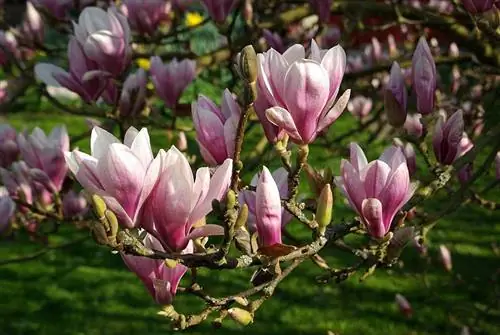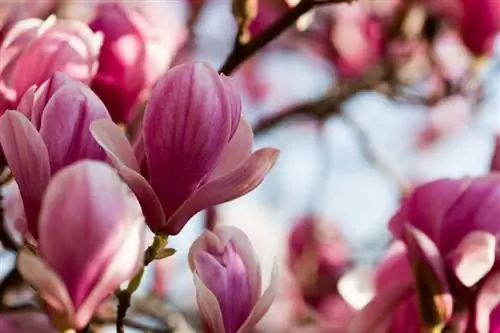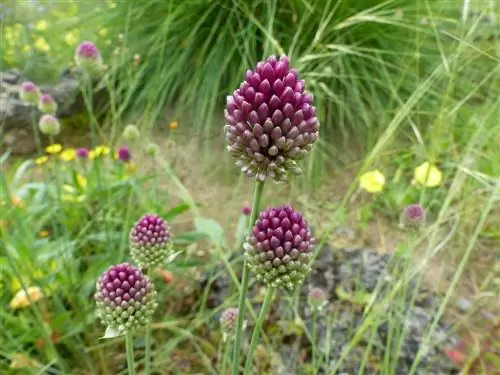- Author admin [email protected].
- Public 2024-01-10 23:11.
- Last modified 2025-01-23 11:22.
Wherever a magnolia tree stages its springtime blossom gala, it attracts everyone's attention. Owning a magnificent specimen should not fail due to open questions about cultivation. All substantial questions about the lavishly flowering tree or shrub are answered here - compact, understandable, practical.

What location and what care does a magnolia need?
A magnolia is an ornamental tree from the magnolia family that impresses with its opulent flowers. The plant prefers a sunny to partially shaded location, protected from wind, as well as humus-rich, deep soil with a pH value of 5.5 to 6.8. Care includes regular watering, fertilizing and, if necessary, cutting back after flowering.
Planting magnolia correctly
The optimal time window for planting is from April to May. A second possibility is in early autumn. Follow these steps:
- The planting pit is 50-60 cm deep and 100 cm in diameter
- Pour a 70 liter bag of rhododendron soil into the hole, add the excavated material and mix everything well
- Place the potted magnolia tree in the middle of the substrate and press the soil down
- Drive the support post into the planting hole and connect it to the main shoot on the bush or trunk
Finally, build a watering edge with the excess soil and give the young magnolia tree a good soaking.read more
Care tips
If the light and temperature conditions as well as the soil conditions at the location are right, the care is kept within a manageable framework. How to care for the magnolia tree with expertise:
- Water the shallow root when it is dry
- Administer a high-quality slow-release fertilizer during the main flowering period
- Alternatively, fertilize every 4 weeks from April to July with compost and horn shavings
- Mulch repeatedly with bark mulch or pine bark
Which location is suitable?
The magnolia tree prefers a predominantly sunny location. As long as the sun balance is good and the shrub is not in a drafty wind tunnel, the location is well chosen.read more
What soil does the plant need?
Three attributes define the ideal condition of the soil for the ornamental tree: humus, deep and a little acidic. A pH value of 5.5 to 6.8 provides both the magnolia tree and the shrub with optimal nutrient availability.read more
When is flowering time?
The paradisiacally beautiful flowering period of a magnolia extends from April to May. In addition, newer varieties are capable of reblooming in late summer, such as the exceptional varieties Cleopatra and Susan. The summer magnolia blooms from June to July, while evergreen varieties bloom from July to September.read more
Cut magnolia correctly
Pruning a magnolia tree is only considered in exceptional cases. The flowering shrub develops its shapely silhouette without any horticultural intervention, especially since cuts heal only with difficulty. In addition, the ornamental tree usually hardly sprouts from its perennial wood. Therefore, limit yourself to thinning out after flowering.read more
Fertilize magnolia properly
A magnolia tree is ideally fertilized when its magnificent blossoms are at their zenith. A granulated slow-release fertilizer is recommended. Alternatively, add compost at a dosage of 1 liter per square meter, plus a handful of horn shavings every 4 weeks. Don't miss watering afterwards!read more
Diseases
A magnolia tree is rarely affected by diseases. If he alth problems arise, they are caused by leaf spot or mildew.read more
Pests
If voracious pests attack a magnolia tree or magnolia bush, they are usually aphids, scale insects or whiteflies.read more
This is how the plant survives the winter
To ensure that a magnolia gets through the winter well, we recommend these precautions:
- Pile up the tree slice with leaves, straw and bark mulch
- Wrap a magnolia tree up to 150 cm high with tree fleece
- Wrap a shrub with jute ribbons or garden fleece
You can also protect a root ball in the pot with bubble wrap from freezing due to frosty temperatures.read more
Propagate magnolia
Suitable methods of propagation are: sinkers, cuttings, grafting and moss removal. Due to the required stratification and the long germination time, sowing is by far the most complex form of breeding.read more
Magnolia in a pot
For a magnolia tree to thrive in a pot, there should be a volume of at least 30 liters. Use a high-quality peat-based potting soil as a substrate. Drainage at the bottom of the pot is essential to prevent waterlogging.read more
Is magnolia poisonous?
The magnolia tree is classified as slightly poisonous. The alkaloid magnoflorine is found in its bark, wood and fruits. Eating the bad-tasting fruits is also not recommended.read more
Magnolia doesn't bloom
If the aristocratic magnolia tree refuses to bloom, it does not feel well. The first step is to check whether the pH is in the ideal range of 5.5 to 6.8. Only in acidic soil is optimal nutrient availability possible, without which neither growth nor flowering is possible.read more
Brown leaves
Brown leaves on the magnolia tree, this symptom indicates a fungal infection, a lack of water or a soil that is too calcareous. If the brown leaves were preceded by a white coating or yellow spots, the magnolia tree is sick. If the pH value exceeds 6.8, the roots cannot absorb enough nutrients.read more
Yellow leaves
Yellow leaves on a magnolia tree or shrub indicate a nutrient deficiency. Such leaf chlorosis occurs when the soil is too calcareous. If the pH value is correct, check the nutrient supply and administer a special fertilizer against chlorosis, such as Neudorff Ferramin iron fertilizer.read more
The most important magnolia varieties
- Kobushi magnolia: the most beautiful magnolia tree in the local regions with white starry flowers from March
- Genie: a top-class shrub among the tulip magnolias that produces red-purple flowers in April and May
- Chrysanthemumiflora: dreamlike flowering shrub that exudes an intoxicating scent
- Daybreak: Magnolia tree impresses with its columnar growth, colorful flowers in bright pink and a unique scent
- Galissoniere: an evergreen shrub that attracts everyone's attention with huge white flowers from April to June
- Merrill: the graceful large shrub dresses in a white flower dress in April and May and smells wonderful
- Yellow Bird: a yellow-flowering magnolia tree that has excellent winter hardiness
The best soil for magnolias
Opulent magnolia blossoms and the best soil conditions go hand in hand. Only plant a magnolia tree or shrub if the soil is well-drained, humus-rich, loose and, above all, slightly acidic in structure.read more
Grow your own magnolia
To experience the development of a magnolia from scratch, you can easily grow the ornamental tree yourself. The following methods can be considered: sowing, cuttings, grafting, sinkers and moss removal.read more
Growing magnolia
The gardening experiment of growing your own magnolias is possible in various ways. The refinement combines a robust wild base with a noble variety, sowing self-collected seeds reveals many surprises, while growing from cuttings is very easy.read more
Planting magnolia
For a magnolia tree to grow quickly after planting, it is crucial to have a sufficiently large planting hole. A diameter of at least 100 centimeters and a depth of 50-60 centimeters create the best conditions.read more
Planting the magnolia
A magnolia tree feels at home where its crown is sunny and its base is shady. With these underplants you can fulfill this wish of the flowering shrub: Marchenbrecher, snowdrops, grape hyacinths and building stars.read more
Transplanting the magnolia
There are two dates to choose from if you want to transplant a magnolia tree: in autumn after the leaves fall or in spring when the ground has thawed.read more
Cutting magnolia in autumn
If you cut back a magnolia tree in autumn, you will most likely deprive the ornamental tree of its next blooms. Since the buds are always created the previous year, cutting - if at all - is only considered after flowering.
The magnolia is losing leaves
If a magnolia loses its leaves in the middle of the growing season, it signals discomfort. These causes can be hidden behind it:
- drought
- Fungal infections, such as mildew
- Inappropriate location
read more
When fungi attack the magnolia
In the event of a fungal infestation, immediate action is required to keep the effects at bay. Cut off all infected leaves, flowers and shoots. Then treat the magnolia tree or shrub with a fungicide that is approved for home and allotment gardens.read more
Mildew: A danger to magnolia?
If a white-grey patina develops on the lush green foliage, the magnolia tree is affected by mildew. To combat it, we recommend either a commercially available fungicide or repeated treatment with a mixture of 100 ml fresh milk and 900 ml water.read more
The magnolia in winter
Regardless of its winter hardiness, the magnolia tree is at risk of significant damage when frosty temperatures and intense winter sun hit its trunk. Cracks in the bark develop, which can cause serious infections. In the fall, wrap the shrub or tree trunk up to a height of 150 centimeters in tree fleece.read more
The magnolia and its winter hardiness
A deciduous magnolia tree is largely hardy from its second year onwards. However, if you prefer an evergreen magnolia bush, this species will only survive the cold season in regions with mild winters or in frost-free, bright areas.read more
A profile
The profile reveals at a glance why the magnolia has enjoyed worldwide popularity for centuries:
- Plant family of the magnolia family with more than 240 species
- Summer or evergreen ornamental tree
- Growth heights from 100 centimeters to 20 meters
- Perennial and hardy
- Flowering period from March/April to May/June or in July/August
- Flower diameter of up to 20 centimeters
- Flower color predominantly white, pink, purple and yellow
read more
The Magnolia Root
The magnolia tree is a shallow-rooted tree. Therefore, when carrying out maintenance work, make sure that the rake does not damage the roots just below the surface of the soil.read more
The buds of the magnolia
The magnolia always sets its buds the previous year. If you consider pruning, this should only take place after flowering.read more
The blossom of the magnolia
You don't have to settle for just one blooming season. Newer cultivars achieve the miracle of lush summer blooms, such as Magnolia siboldii. In addition, an evergreen magnolia bush delights us with its splendor of flowers from July to September.
The intoxicating scent of magnolia blossoms
The intense scent of a magnolia blossom inspires the creators to continually create new perfume creations. Above all, the creamy-sweet scent of tulip magnolias or a magnolia tree with a hint of lemon delights spoiled noses.read more
Does the magnolia bloom in August?
Don't be surprised if your magnolia tree blooms in August. Newer varieties have mastered the art of reblooming in summer, such as the tulip magnolia or the purple magnolia. The magnolia tree Magnolia sieboldii is even specifically bred for summer flowering.read more
The fruit of the magnolia
Following the magnificent blossom, small green fruits develop on the magnolia tree and the flowering bush. Over the course of the summer, these collected fruits turn reddish, burst open and distribute the seeds in the surrounding area.read more
Is the magnolia fruit edible?
The cone-shaped collected fruits that appear in late summer are reddish-brown in color and up to 10 centimeters long. Aside from tasting unpleasantly bitter, they also contain the toxic alkaloid magnoflorin. Consumption causes nausea, vomiting and other symptoms of poisoning.read more
Magnolia seeds
The cylindrical collected fruits are typical of the magnolia tree. These contain individual follicles with red-brown seeds. These seeds are surrounded by a fleshy shell to encourage animals to eat them.read more
The leaves of the magnolia
If a magnolia tree suffers from a lack of nutrients, it will simply drop its leaves. Therefore, fertilize regularly with compost and horn shavings once flowering begins. Alternatively, a granulated long-term fertilizer for ericaceous plants covers the needs of nitrogen, phosphorus, potassium and minerals.read more
Magnolia offshoots
Early summer is the ideal time to propagate a deciduous magnolia tree using cuttings. To do this, cut semi-lignified cuttings 15-20 centimeters long. On the magnolia bush, breeding is particularly easy using lowering tools.read more
The size of the magnolia
One of the fundamental factors in a purchase decision is the expected size of a magnolia, because there are clear differences here. In our regions, the classic magnolia tree easily reaches 10 meters or more, while small star magnolias grow up to a size of 100-200 centimeters.read more
The growth of the magnolia
The species determines the growth of a magnolia. While the mighty magnolia tree Magnolia kobus is content with an annual growth of 20-30 centimeters, the large-flowered magnolia shrub Merill is significantly faster in growth with up to 50 centimeters annual growth.read more
The height of the magnolia
The magnolia has specimens at the right height for almost every cultivation variant. The options range from the impressive Kobushi magnolia with a height of more than 10 meters to the distinctive small shrub Alex, Susan or Wildcat with a height of 100 to 200 centimeters.read more
The magnolia as a bush
If you're looking for the most beautiful magnolia bush, you'll find a star magnolia. Both the species and all its varieties thrive as a dense shrub and bloom from April to May.read more
The magnolia as a hedge
In order to cultivate the magnolia as a hedge, the focus of interest is on species and varieties that thrive as large shrubs, such as the tulip magnolia. If you choose an evergreen tree, like Fariy Magnolia, you can also create privacy all year round.read more
The magnolia as a standard tree
Almost every magnolia tree is predestined to be a standard tree. The same applies to the magnolia bush, which can be trained into a standard tree for small gardens.read more
The small magnolia
If you look for a small magnolia, it is primarily the noble hybrids. In addition, the star magnolia, with a height of 100-150 centimeters, proves to be comparatively small in growth.read more
The magnolia as a bonsai
The lavishly blooming star magnolia is ideal for bonsai. Almost all styles can be considered, from the free, upright form to multiple stems.read more
The magnolia as a houseplant
An evergreen magnolia bush or the delicate star magnolia certainly has what it takes to become a houseplant. In this case, a sunny location comes into focus because otherwise the ornamental tree will develop unsightly horny shoots within a short time.read more
The magnolia in the garden
For a magnolia tree to do its best in the garden, the location is crucial. The most important aspects are:
- Sunny to semi-shady location
- Protected from strong winds
- Humoser, deep soil without waterlogging
- A pH value of 5.5 to 6.8
The magnolia on the balcony
In order to transform the balcony into a springtime sea of flowers, the large magnolia family comes up with small-growing species and varieties. At 100-300 centimeters, star magnolias remain delicate enough to thrive in pots.read more






